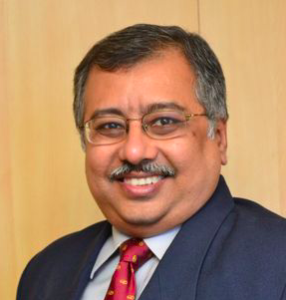For over a decade, the Mahindra Group has been leveraging its size and stature for maximum sustainability impact. Mahindra’s companies span 22 industries, operate in over 100 countries, and employ more than 240,000 people. Founded and headquartered in India, the Group is a US $20.7 billion global federation of companies.

So when Mahindra launched its “rise against climate change” campaign, the impact was significant. Not only is it the first Indian company to set an internal carbon price, it has planted over 15 million trees and committed to setting science-based targets. Its automotive business recently announced its intention to be carbon neutral by 2040.
Mahindra’s sustainability initiatives are spearheaded by Anirban Ghosh. Under his leadership, Mahindra has developed an award winning sustainability framework and become a founding member of the Carbon Pricing Leadership. Ghosh, a noted speaker on sustainability, has been featured at the Global Climate Action Summit, COP21, the World Circular Economy Forum, and GRI Global. He’s acknowledged as a Distinguished Sustainability Officer.
Bard MBA Candidate Jesse Gerstin spoke with Ghosh about the company’s approach to sustainability, including its carbon pricing initiative.
The following Q&A is an edited excerpt from the Bard MBA’s March 1st The Impact Report podcast. The Impact Report brings together students and faculty in Bard’s MBA in Sustainability program with leaders in business, sustainability and social entrepreneurship.
Reprinted from GreenBiz.
GERSTIN: TELL US ABOUT MAHINDRA.
The Mahindras are actually a very interesting group of about 20 companies. We started a little more than 70 years ago, before India became independent. The group spans industries like automotive, farm equipment and agriculture, construction, logistics, finance and technology. We even include little planes and boats.
We’re now present in more than a hundred countries, with significant operations in South Korea, Turkey, Finland and the United States. Current revenue is in excess of twenty billion dollars, and there are about 240,000 people who work across the group.
So, it’s a fairly wide spectrum that has built up over time. We call ourselves a federation of companies because most of the companies have a lot of independence to make their own decisions. Very little is dictated by the corporate office.
One of the things that does get coordinated by the corporate office is sustainability. We follow a common sustainability framework for the work that we do for the future.
GERSTIN: THE MAHINDRA COMPANIES HAVE SIGNED ON TO A NUMBER OF SUSTAINABILITY TARGETS. HOW ARE YOU ABLE TO TAKE ON ALL OF THESE COMMITMENTS AND STILL BE PROFITABLE AS A GROUP?
This work falls squarely in the space that overlaps planet and profit. You can do both things at the same time: become more profitable, and therefore become more resilient and competitive, and also make a positive contribution towards positive climate action.
The biggest challenge we have from a climate perspective is to become net neutral or net positive by the second half of the century. Every single one of these commitments is actually a step in that direction. So, doubling energy productivity, adopting 100% renewable energy—both of these help to achieve science-based targets which in turn are actually an intermediate step towards reaching carbon neutrality, which we have committed to the entire group achieving by 2040.
There is no trade off here. More action in this space leads to greater profitability.
GERSTIN: YOUR CHAIRMAN, ANAND MAHINDRA, HAS REPRESENTED THE PRIVATE SECTOR AT A NUMBER OF HIGH-LEVEL FORUMS AROUND CLIMATE CHANGE. WHAT DOES IT MEAN THAT HE’S SO VOCAL ABOUT MAHINDRA’S SUSTAINABILITY INITIATIVES?
It has two very important implications. One, you know you are headed in the right direction and have support. Two, we are a very large corporation, and when you have a chairman encouraging you to go forward in that direction, all doubts get set aside and you’re able to get far more traction than you would otherwise. It’s a huge help to have the chairman of your company openly support the cause.
GERSTIN: WHY IS INTERNAL CARBON SOMETHING YOU ACCOUNT FOR, AND WHY DO YOU THINK INVESTORS ARE LOOKING AT IT AS A WAY TO MEASURE ESG?
I’m going to share with you something you don’t normally hear in the discourse on carbon pricing. Everything you hear about adopting a cleaner option and reducing risk—it’s all true. Here’s what it does within a corporation.
We’ve implemented carbon pricing by committing to invest ten dollars for every ton of carbon we emit into technologies that help reduce the carbon footprint. Because we already know what our emissions were the previous year, the amount of money that will be available for investment is reasonably clear in the following financial year. Our sustainability folks and our project folks know that there’s a kitty of money available, and that if they put up a project that meets all the necessary parameters they don’t have to waste time negotiating with asset management or capital processes for every single project.
This frees up their time to generate more projects, which is why our ability to invest in the space has increased more than ten times since the time the carbon price was put in place. The number of projects we’ve been able to do has gone from low double digits to reasonably high triple digits in the energy efficiency and renewable energy space.
As far as investors are concerned, I think they’ve always wanted to see whether an organization is going to be profitable in the short run and whether it will continue to exist in the long run. All that’s happened is that a few new variables have been added onto the ones they had to look at earlier.
Under this scenario of climate change, the corporation must do all of the good things that it was doing in the past, but at the same time rejuvenate the environment and be very conscious about the communities in which it works. So now there are a couple of extra things that need to be done to ensure that short-term profitability and long-term sustainability are not at risk.
It’s an evolving area of knowledge and information. It’s still early days, but I wish more investors would come on board.
